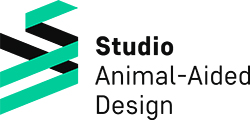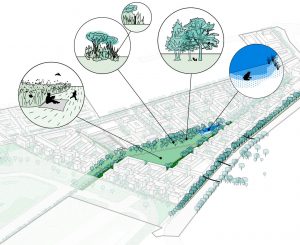PRACTICE
How can Animal-Aided Design be applied in planning procedures?
Animal-Aided Design can be used for project-based planning and in the context of urban planning.
In the context of project-based planning, the Animal-Aided Design method can be used to plan measures for animals in urban developments. These can be projects such as housing construction, for example the construction of apartment buildings, but also the planning of commercial properties. Animal-Aided Design can also be used in the planning of public buildings such as museums (see example of Biotopia). It is important for planning with Animal-Aided Design that the decision on target animal species for which measures are to be planned is made in the first planning phase (HOAI phases 1 and 2).
The Animal-Aided Design method is not only applicable for new construction projects, but can also be used to plan animal-friendly measures in refurbishment projects, such as climate adaptations or building modernization. A change in the maintenance procedures of the greenspace around properties can also be used to create a habitat for certain animal species – see brochure “Animal-Aided Design in the Living Environment” (only in German).
Animal-Aided Design can also be used on a larger spatial scale, for example when planning a new urban district or an industrial estate. Here, the Animal-Aided Design method is used to develop proposals as to which measures can be implemented by developers for which animal species (e.g. the Schumacher Quarter Airport Tegel project, Berlin).
At the urban planning level, Animal-Aided Design can be used to plan measures for target species in such a way that sufficiently large populations are created and that the individual sub-populations are sufficiently connected, both each other and with populations outside the city.
CERTIFICATION
Studio Animal-Aided Design offers certification for projects developed according to the Animal-Aided Design method.
Buildings and adjacent open spaces are certified according to an AAD criteria catalogue. Certification is done on the basis of the planning documents, and an on-site inspection. If this assessment is positive and the building fulfills critical site factors (habitat functions) for the selected target species, the project will be certified. The certification is valid for 10 years. If desired, the successful certification can be presented to the public with a plaque on the building and in various media.
CERTIFIFACTION BENEFITS FOR CUSTOMERS
The customer acquires the following advantages with a certified project:
- Certificate stating that the building and/or outdoor facilities have been constructed according to the principles of Animal-Aided Design
- the right to advertise with this certificate, both on the building and in public advertising for the company, in print or digital (websites and social media). The AAD logo is provided by our site.
- positive certified projects will be published on the Animal-Aided Design website as best practice projects
CERTIFIFACTION CRITERIA
Certification is based on the following criteria:
1. Target species selection and species portraits
- Application of target species concept
- Data analysis on species occurrence
- Plausible target species selection and analysis of connectivity to existing habitats
- Quality of species portraits, taking full account of the life cycle
- Integration of critical factors of target species into project design
- Participation procedures in the selection of target species
2. Adaptation of building
- Planning and implementation of suitable technical solutions to meet animal requirements (e.g. suitable facade quarters)
- Development of innovative technical and planning solutions
- Full implementation of all critical factors
- Maintenance plan to ensure the long-term functioning of the measures
3. Adaptation of open space
- Preservation of existing vegetation, especially old trees
- Planning of target species-specific vegetation
- Target species-specific maintenance plan to ensure the long-term functioning of the measures
4. General criteria – Consideration of general nature conservation concerns
- Avoidance of animal traps (e.g. open cellar shafts, water bodies with no exit possibility)
- Bird safe glass use
- Animal-friendly use of light
5. Quality control during construction
- Species protection measures during the construction work
- Construction process with ecological construction supervision
- Final technical test of the measures implemented – Monitoring concept
CERTIFIFACTION PROCEDURE
1. Before completion of project, ideally at the beginning of the planning process: preliminary examination of the existing situation and examination of the already existing planning documents
2. Submission of the planning documents (ideally in 3 stages: preliminary design, draft, detailed design)
3. Examination of the following documents – Species portraits – Description of the measures implemented to meet the requirements of the animals – Plans (preliminary draft, design, detailed design)
4. Proof of quality control during construction
5. On-site inspection
6. Certification


